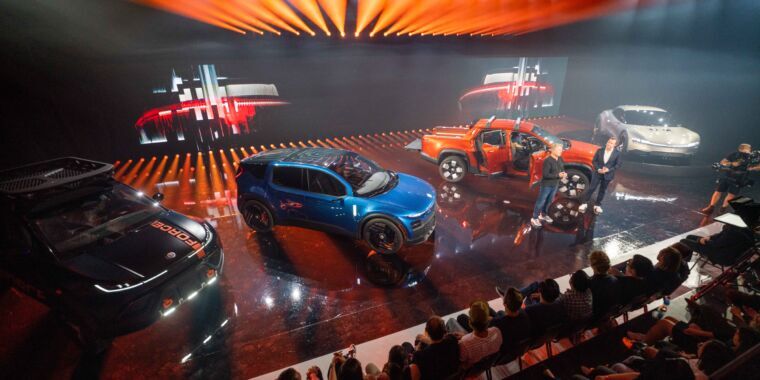Fiskars sounds more like a car company, lol
I did the same! “Why is my crafting crack company making cars now?!”
The sub $30k seems like marketing as almost no new cars have been selling around MSRP for the last few years.
It’ll be interesting to see if Americans would ever go for a “City Car”. I believe Citreon are bringing the ami to the USA and I’d be tempted to get one a second car - it’s certainly well under that pricepoint.
Just some thoughts:
I’ve owned a first gen Leaf for about 6 years and it’s my daily. I bought it for very cheap. My commute is about 25 miles total on surface streets and I’ve put about 40k miles on it. The usable range is probably 40 miles if you want to take care of this style battery, which I do because a new one is the value of the car.
It’s been a good experience but I need to have a 2nd car or a rental if I want to leave town. It’s worked for me, but there’s no way anyone else I know would accept this.
IMO, the experience of “refilling” the car will need to be much quicker for wide adoption in the US, especially for those who are not able to charge at home. You’d also have to convince people that going electric is better for some reason, be it a feeling that you’re saving the earth(which is debatable depending on all kinds of factors) or that the performance of some models is pretty awesome.
It’s the same as the pick-up truck argument. It seems insane to me to drive a $60k vehicle so that when you need to move a piece of furniture you can… i can literally rent a pickup for an hour for $20. For the half-dozen times a year that I need to move something it seems ridiculous to own it.
America loves small cars… When gas prices are way up. Remember the VW beetle? I remember during the great recession when gas was up to $4 a gallon, suddenly everyone wanted a small, fuel efficient car.
Funny story, everyone here owns a giant car - an SUV or a pickup - but there’s been a noticeable addition of scooter-like vehicles darting between them, sometimes with closed cabins.
It’s like shrinkflation in reverse. Bagged pretzels keep getting smaller until a new “jumbo” package comes out that basically serves the same purpose the main line originally did.
To be honest I don’t see much use for this vehicle in the US. Even in most cities, you will likely need to drive on the highway sometimes, which this can’t do. And if I’m not on high speed roads, why wouldn’t I just use a bicycle? Particularly as e-bikes are now widely available and far more affordable than this thing.
Here in Montreal we have a very popular car sharing company that allows many of us to not own cars.
It’s biggest issue at the moment is that the company can’t buy cars as quickly as demand increases. This type of cars would be a great addition to their park since a lot of the trips their customer do are short inner city trips.
As a parent, I don’t know if I agree. It takes significant effort to get my kid out on a bike as our road system isn’t great for them. (My city is actually fairly good, but we still can’t, for example, get to his school without needing to ride on the road)
If it could do 45mph and had a 40 mile range then it’d work for nearly all our in-town trips. We have a phev that can only do about 20 miles on battery and at the start of the pandemic we went 9 months without needing to put gas in it. I wouldn’t want it as our only vehicle but it’d be pretty viable as our secondary one.
The top speed is 28. So that’s what I’m saying, this vehicle occupies largely where riding a bike is fairly safe.
Maybe in some places, but that’s definitely not true in my city. The intersection i can see from my home office window has a 35mph speed limit and their are accidents there all the time. I haven’t seen anyone badly injured, but there was at least one that went up a berm, over a multiuse bike path, through a fence and crashed into a neighbor’s house.
I’d totally take my 9 yr old on a 3-4 mile bike ride if we’re going somewhere that we can get to on protected bike lanes, but there are lots of places in this city that aren’t accessible that way and I’d be much happier in a small city car. I’ve taken him along a 45 mph road on a few occasions and it’s nerve-wracking, legally you aren’t allowed to pass a bike until you can give them 3 foot of space but it happens ALL THE TIME and it’s a real deterrent to cycling for us.
The 28mph top speed i think is a european classification thing, but yeah that’d be the showstopper for me - not the size or range.
What a cool little car!
Their Oli concept car is probably even cooler and would likely work better in the US market.
Here is an alternative Piped link(s): https://piped.video/watch?v=JrFupUJALCY
Piped is a privacy-respecting open-source alternative frontend to YouTube.
I’m open-source, check me out at GitHub.
That looks amazing!
The issue with the Ami is that it is closer to a fast golf buggy than a standard car (even a “city car” in the standard sense can keep up at highway speeds, like Japans Kei class) if it were available in a country like the US, it could really only be targeted at the few small communities where NEVs are encouraged. Technically they can be legal in most of the country to drive on roads up to a certain speed, but only a few areas have specific incentives and laws for them.
If more US states incentivised small, low to mid speed short range EVs as second cars for short local trips, made them the budget option for the many, many families that don’t need multiple full sized cars would take one on as their first EV.
I mean the real way forward would be walkable towns, mixed zoning in suburbs, disincentivize large vehicles, hell disincentivize driving in general, expand bike lanes, dedicated bus lanes, invest in other options like light rail, remove “stroads”, shut down the false narratives that every car needs 1000miles of range, every house needs a multi car garage, every shop needs a theme park sized car park, etc etc etc…
Totally agree. I think the lack of mixed zoning is fucking weird about this country. When I lived in edinburgh I was upstairs from a bar and an indian restaurant - but where I live now it’s almost a mile to get to any kind of retail or dining.
I was also reminded in a recent story about revitalizing downtowns that lots of asian cities have all kinds of stuff inside high-rise buildings. Like you’d got a noodle restaurant that was on the third floor of a random building in hong kong. But the US seems to practically require that they be entirely office space.
deleted by creator
I remember when Tesla announced the Model 3 as a sub-$30k car. Since then there have been other EVs hitting that mark, but I still harbor some skepticism whenever prices get announced that far in advance of release. But it’s good to see more EVs entering the market!
Fake edit: I looked it up, and Tesla is offering the Model 3 starting at $40k. That’s more than 30, but tbh it’s not as pricey as I thought it was.
My biggest problem has always been the available range. The charging infrastructure in the South is largely nonexistent and I work 60 miles from my house. The only way I could go electric would be to gut and rewire my house to add a charger (The 120v one wouldn’t cut it) and have a way to top up the charge at work during the winter. The cost of the car itself is only half the problem for me.
I was looking real hard at the Lightning when it came out and was about to pull the trigger on the truck and everything associated with it when the towing range came out. Yikes! I haven’t been that disappointed in a long while.
It’s still too much though… Specially looking at the quality you get
It’s pretty close to $30k for the standard range model 3 right now when you factor in $7500 in federal credit + your states local incentives. Several progressive states offer like $2k. Plus a referral program gets you another $500.
Not many EV’s fit this category and qualify for the full 7500 credit. More competition the merrier. But with any EV hitting the market I’ll believe it when I can touch and feel it in person.
deleted by creator
This is the best summary I could come up with:
With shades of Lotus circa 2010, it seems there’s something for most tastes, with a powerful four-door GT, a versatile pickup truck, and an affordable electric city car.
“We want the world to know that we have big plans and intend to move into several different segments, redefining each with our unique blend of design, innovation, and sustainability,” said CEO Henrik Fisker.
Starting with the cheapest, the Fisker PEAR—a cutesy acronym for “Personal Electric Automotive Revolution”—is said to use 35 percent fewer parts than other small EVs.
Oh, and it has a frunk, which the company is calling the “froot,” something that will satisfy some British English speakers like Ars’ friend and motoring journalist Jonny Smith.
Fisker plans to contract with Foxconn to build the PEAR in Lordstown, Ohio, meaning it would be eligible for federal tax incentives.
There’s no price for this one, but Fisker says its all-wheel drive powertrain will boast 1,000 hp (745 kW) and will hit 60 mph from a standing start in two seconds—just about as fast as modern tires will allow.
I’m a bot and I’m open source!
Is this the same fisker that recalled most/all (I can’t remember the details) of the karma’s? For battery problems?
Hard to imagine there being another Fisker electric car company that has delivered vehicles. I’ve seen a few FIskers on the road and they always have looked pretty nice. No idea what it’s like to ride in one.
Knowing that it will be assembled by Foxconn gives me pause. They have been able to achieve reasonable levels of quality, but I don’t put much trust in a company run by con men.
I saw this and thought you meant made in China too. But reading the article, it’s a foxconn plant in Ohio. But not sure if new plant or existing, but at least it’s made here.
I did get that and it doesn’t affect my opinion. They are less likely to use slave labor in the US than in China, but their executives also lie more in the US than they do at home (because the consequences are a lot more serious in China). Agreements and contracts mean nothing to them. Among other problems, that means their quality control is entirely dependent on whoever hires them watching everything they do all the time.
Let us not forget when Foxconn came to Wisconsin and convinced a city council to claim eminent domain and demolish an entire neighborhood in a secret vote in order to build a Foxconn plant. They promised thousands of well paying jobs but then when they opened the plant, only hired a tiny fraction of the total and barely utilized the plant at all.
Apple appear to do fine with them
Apple has a lot of its own people on site to validate all the work.
What do you mean? Another company cannot do that? Assuming it’s even true because I have no idea
Yeah, you can outsource key parts of your business but absolutely need to keep your eyes on it. We won’t know if they are on it or not for a while.
True. I work for a supplier in the auto industry. Any time we get a quality claim from a customer, they’re on site a few days later to see the line, find out why it happened, and what we’re doing about it. Toyota, Nissan, GM, etc all have that infrastructure in place. I doubt Fisker does.
I don’t know if I want froot to catch on because it sounds ridiculous or not because I hate how ridiculous it is.
But you have to admit a car called Pear must have a froot
I am not buying an EV until they are using LFP batteries. LiFePo4 have so much more life…I really don’t want to be replacing huge banks of lithium ion in 5 years.
Some manufacturers seem to be getting on board with this. Disappointing that hedge clipper (what I know Fisker for) here isn’t one of them. Sorry…that is Fiskar, a totally different company.
Could you link some stats for this?
My 8yo Outlander still has ~80% of original range on lithium batteries.
You might be one of those people keeping cars for 20 years, but majority swap cars much more frequently so lithium battery degradation is not really an issue.
Yeah well then I hope I can replace the battery easily and for cheap when I buy the car second-hand.
What major part of a modern ICE car can you replace easily and for cheap?
Cars are expensive and complicated as fuck. I don’t like it, but that’s just life in 2023.
Actually, electrics are a lot simpler, so relatively cheap battery swaps isn’t out of the question if they’re designed right.
Transmission is pretty much the only component I can think of that’s simpler. I have four motors (5 with ICE) instead of one. Lots more cooling lines. Ton of high voltage / high amperage wiring. And a ton of silicone chips that make all that work together.
I agree that you can build an electric car simpler than an ICE car, but there are no real world examples other than a few unique cases like Edison Motors.
I feel like maybe you’re counting components wrong. An ICE has… I actually don’t know, but a lot of moving parts. It looks really hard to pull a combustion car apart to swap anything major. I know less about the cooling, I admit.
Hybrids do not count here, they actually add together the complexity of both.
Why are you getting into the whole powertain & drivetain? I was just talking about the goddamn battery!
I went to school for electro-mechanics, electric drive trains are much simpler. The electronics have a couple of details, but they are basically scaled up computer psu-s. Biggest problem for car manufacturers is probably designing a different car then the ones they made before. Bateries are the most expensive part and should degrade faster then the motors (decades), maybe even electronics (10 years, depends on design).
But yea cars have gotten too expensive in the last 15(?) years.
- oil
- battery
- spark plug
- tire
- many others…
Emphasis on the battery
And yes, you’ll need the right tools, knowledge, skill, and time; but where there’s a will, there’s a way.
I’m just hoping the automakers won’t start glueing and plastic soldering stuff just like it’s done in newer laptops.
deleted by creator
For starters, you can replace the equivalent of the battery: fuel
Don’t get me wrong; my next car will be an EV. But it is disingenuous to hand wave the reality that EV batteries are expensive and difficult to replace, somewhat negating the economical and environmental benefits.
I do all of my work on my own cars in my home shop, including things like dropping transmissions. This is why I’m able to keep cars for over 20 years. But there’s no way I would be able to even start to replace an EV battery pack simply due to the weight.
But, for me anyway, that’s not a compelling excuse not to get an EV. It’s the way of the future and, by the sheer nature of getting one, I’m promoting their adoption, encouraging their innovation, and driving down the cost overall. So I look forward to it, even if there are some inconvenient truths.
Ah yes, let’s get rid of ICE vehicles so we can churn EVs every 5 years, that’ll help the environment taps forehead
Interesting. I have no stats. Do you have any idea how many miles or how many charge/discharge cycles you’ve done?
A little over 70k miles on odo. Covid subtracted about a year worth of miles. I can’t even guesstimate charge/discharge cycles unfortunately.
When I bought the car I couldn’t charge at home for the first year so I wasn’t charging much and drove it like a regular hybrid.
After 1 year I was able to charge at home and doing about 90% electric driving. Discharging ~100% and recharging fully every night on days I drove the car.
LiFePo4 batteries have lower energy density than other Lithium Ion batteries and they’re more expensive. So while they have much longer life your EV running LiFePo4 is going to have shorter range.
I’d love to be able to get a small lifepo for the city and keep my ICE for longer distances.
I think the real short term answer is a plug in hybrid LiFePo4 where the ICE is basically just a range extender.
I would absolutely take that trade-off. I don’t need a lot of range.
The MG4 is a sub 30 000€ available in Europe that uses LFP battery in the entry level version.









